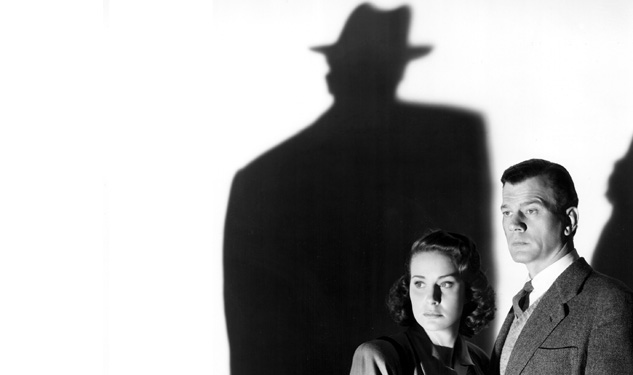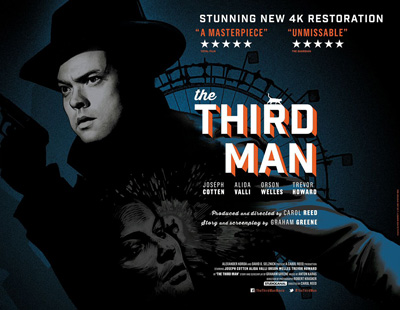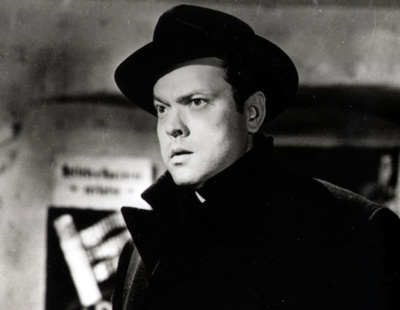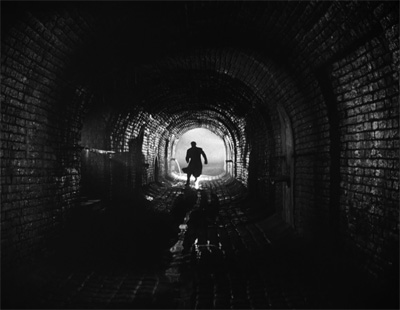
- Industry
The Second Coming of The Third Man
Written by Graham Greene (possibly inspired by the adventures of his friend and double British agent Kim Philby) and directed by Carol Reed, The Third Man (1949) was a collaboration of two legendary producers: Alexander Korda and David O. Selznick. Nominated in three categories, the picture won an Academy Award for Robert Krasker’s remarkable expressionist black and white cinematography. And Anton Karas’ haunting “The Third Man Theme”, performed by the composer on a zither, was a worldwide hit. And all the accolades were more than well deserved. Simultaneously melancholic and hard-boiled, the picture is beautifully acted by Joseph Cotton, Alida Valli and Trevor Howard. Orson Welles has a small role but is marvelous as the epitome of menace. Rialto has now re-released the first major 4k restoration of this movie, timed to Orson Welles’ 100th birthday (May 6, 2015). The Third Man is playing this weekend in selected theaters in Los Angeles as part of the TCM Presents Film Cycle. The HFPA’s own
H.J. Park looks at what makes it a noir gem. 
The Third Man (1949), written by Graham Greene and directed by Carol Reed, was a movie about a crime, friendship and betrayal. It’s a perfect film noir, with all the genre’s key elements: a mysterious, ghost-like main character, Harry Lime; a dark and dramatic chase in the sewers under the city of Vienna; a highly contrasted black and white cinematography creating shadows and an uneasy, anxious atmosphere; and the haunting music played on a zither, sometimes pulsing, fast, sometimes plaintive and melancholic. Together with the beautiful acting, the eerie aura of war-torn Vienna (which reminds me of Korea after the war), and doomed love story under it all, the movie feels fresh even after numerous viewings.
Recently I read the script for the movie. The dialogue is cynical, short, and strong. It reads like a hard-boiled detective story, exuding the atmosphere of a dismal February winter. The movie starts with a voice over narration by Carol Reed, while the zither playing a jarring melody on strings. Holly Martins (Joseph Cotten), a run-down writer of second-rate western novels, responds to an invitation from an old friend, Harry Lime (Orson Welles) to come see him in Vienna, a divided post-war city, sectioned and governed by the victor: Americans, British, French and Soviets.
When Holly arrives at Harry’s apartment, the manager tells him Harry was killed by an automobile accident a few days ago, and a funeral is to be held that very day. At Harry’s funeral Holly has a glimpse of Anna, Harry’s girlfriend, a Czech actress (Alida Valli) .
At the funeral, Holly learns from a British military policeman, Major Calloway (Trevor Howard), that Harry was a black marketer in military supplies. Harry also sold diluted penicillin to sick children, resulting in their deaths. Determined to clear his friend’s name, Holly decides to investigate further and find out what happened to Harry. He soon discovers that there was an unidentified Third Man among the people who moved Harry’s body. To find out this man’s identity, he questions every person who knew Harry. 
Among them is Anna. While investigating Anna, Holly slowly falls in love with her. In his yearning glances one can glimpse the depth of Holly’s unrequited love that, combined with his need for justice, will lead him to eventually betray his friend Harry.
One hour into the movie Harry finally makes his grand entrance – on a doorstep, a hat and a thick coat on, a playful and dangerous grin on his lips. 
Soon he is being chased down the maze of Vienna’s sewers. It is a riveting sequence: Harry running from the police, his silhouette splashed on the walls; the sound of the footsteps of both chased and chasers, the sound of sewage water flowing around; Harry’s nervous glances lit by flashlights, the close-up of his fingers trying to lift the manhole cover. The famous sequence was actually shot on a replica of the Vienna sewers built in London’s Shepperton’s Studios. After the movie opened, however, the “Third Man Sewers Tour” became a popular tourist attraction in Vienna. 
The last scene is considered one of cinema’s most beautiful. After the second funeral of the twice-dead Harry, Holly’s eyes follow Anna walking away, down a street lined with naked oak trees, a blank expression on her face, purposefully ignoring him. Green actually wrote a happy ending, but the producer David O. Selznick changed it to an unhappy, more realistic, resolution. The Central Cemetery, where both funerals were shot, is where Beethoven, Brahms, and Shubert are buried.
Welles himself wrote most of Harry’s famous parting words to Holly, “After all, it’s not that awful … you know what the fellow said … In Italy for thirty years under the Borgias they had warfare, terror, murder, bloodshed – they produced Michelangelo, Leonardo da Vinci and the Renaissance. In Switzerland, they had brotherly love, five hundred years of democracy and peace, and what did that produce? The cuckoo clock. So long, Holly.”
If I am asked what movie would I want to take if I am marooned in a deserted island, I would say, without hesitation: The Third Man.
H.J. Park